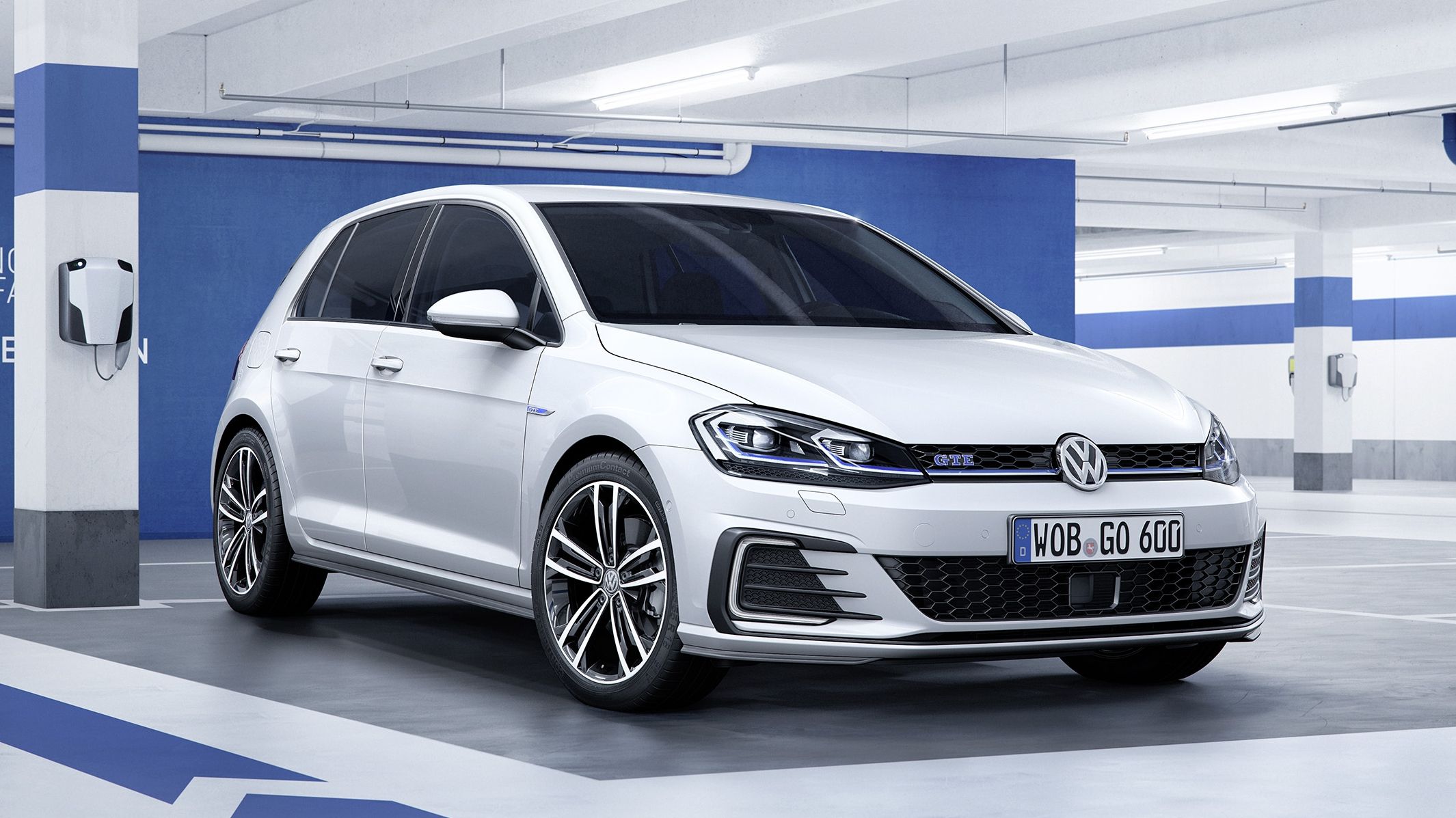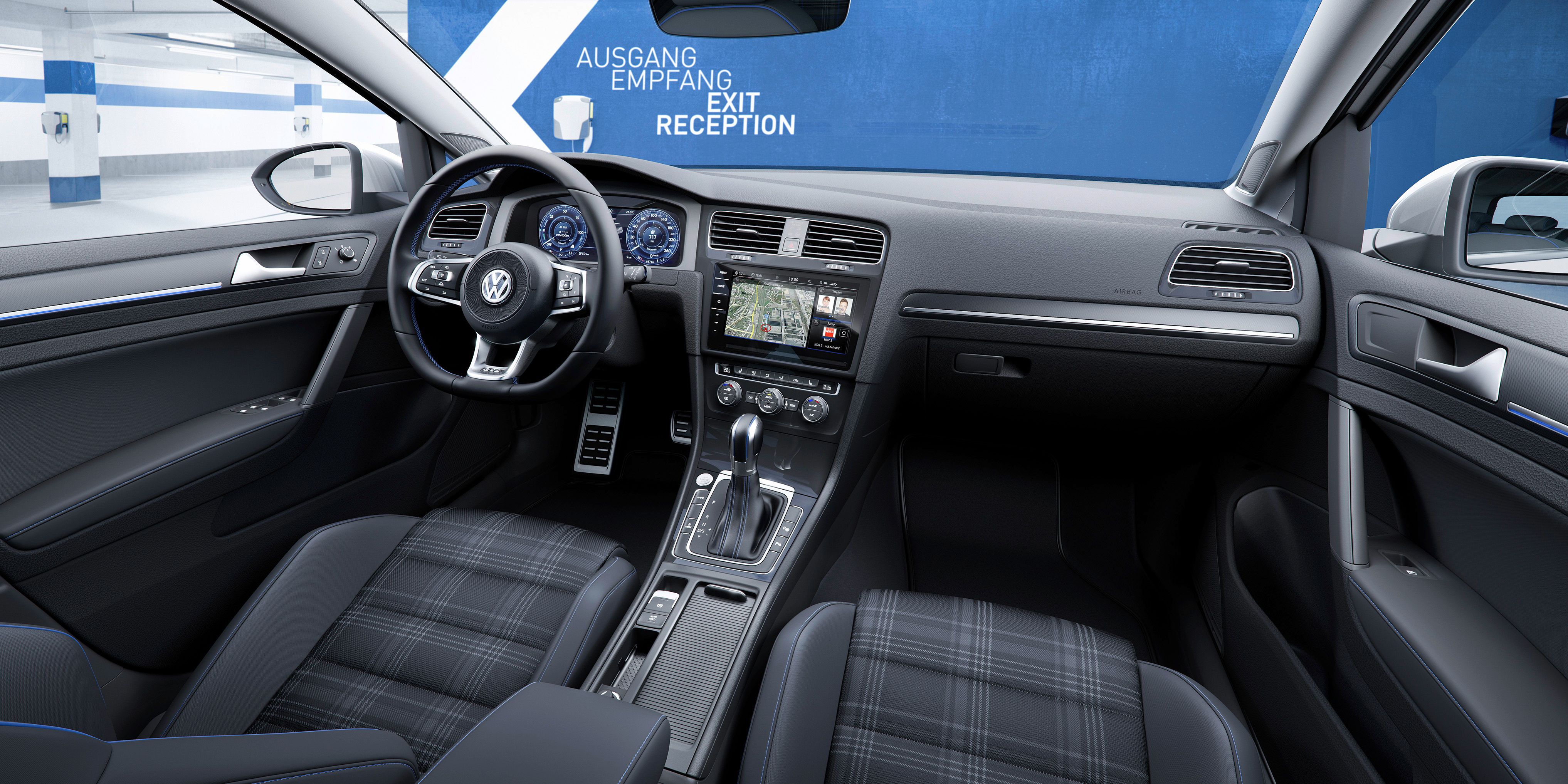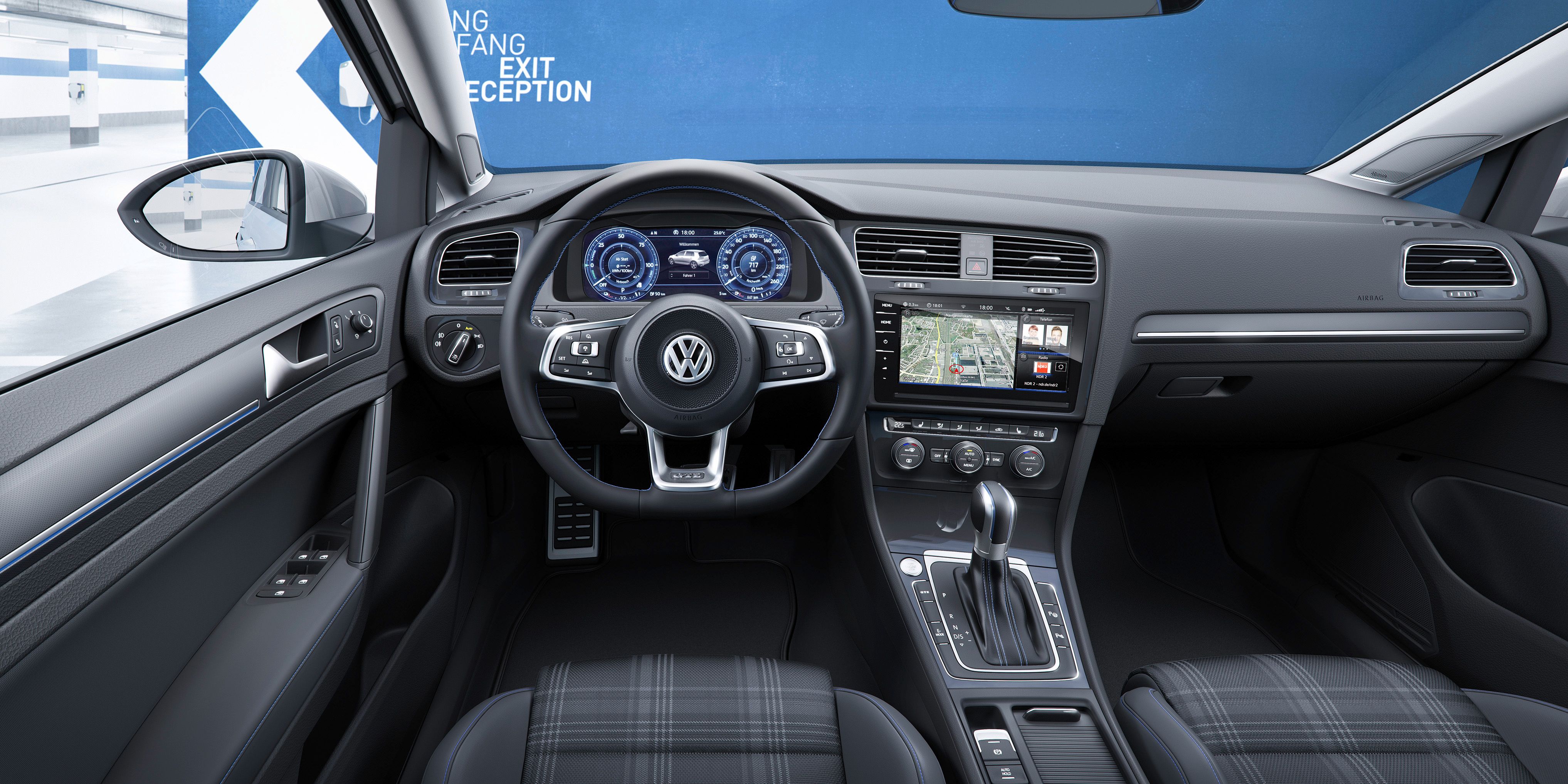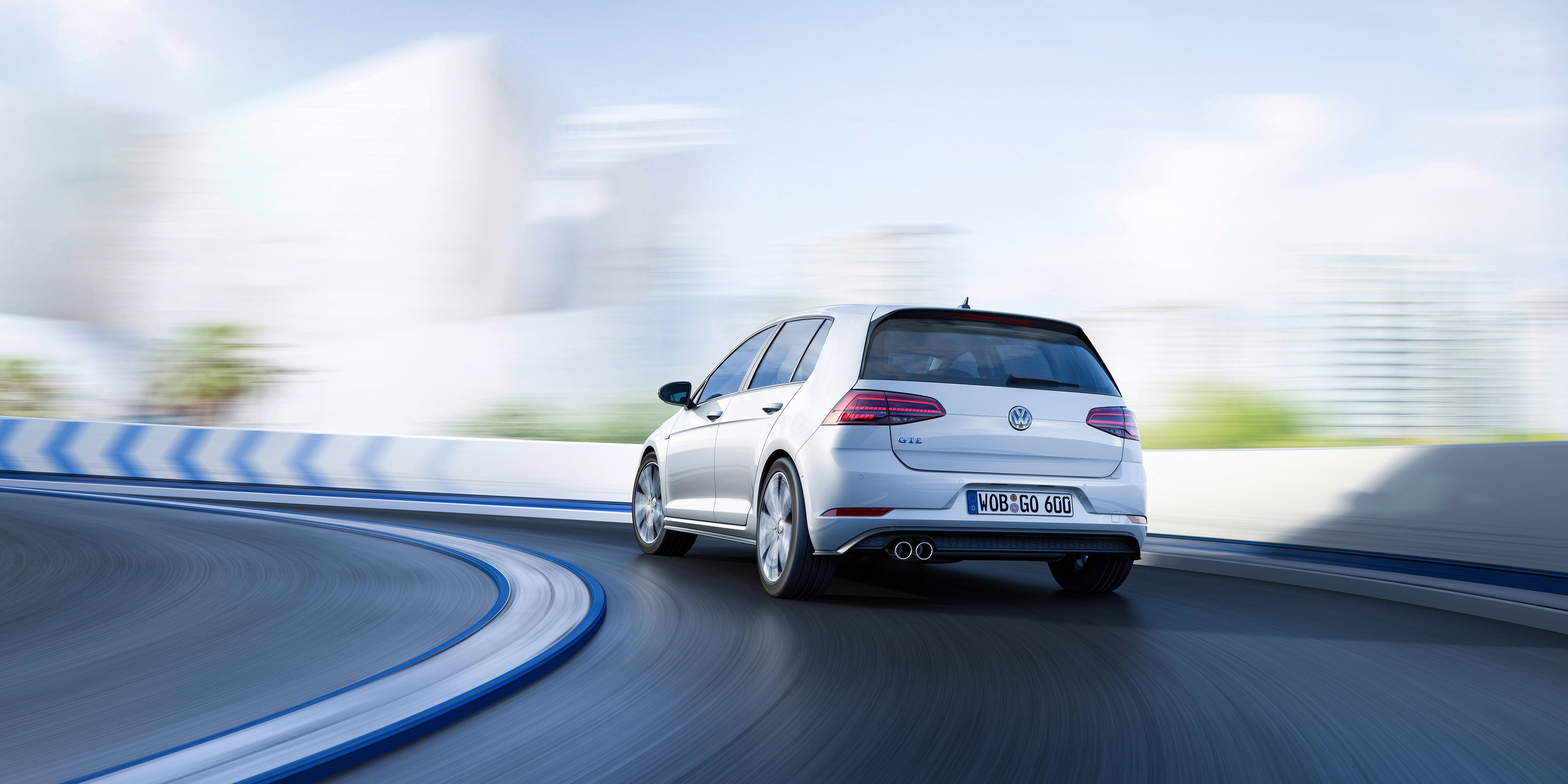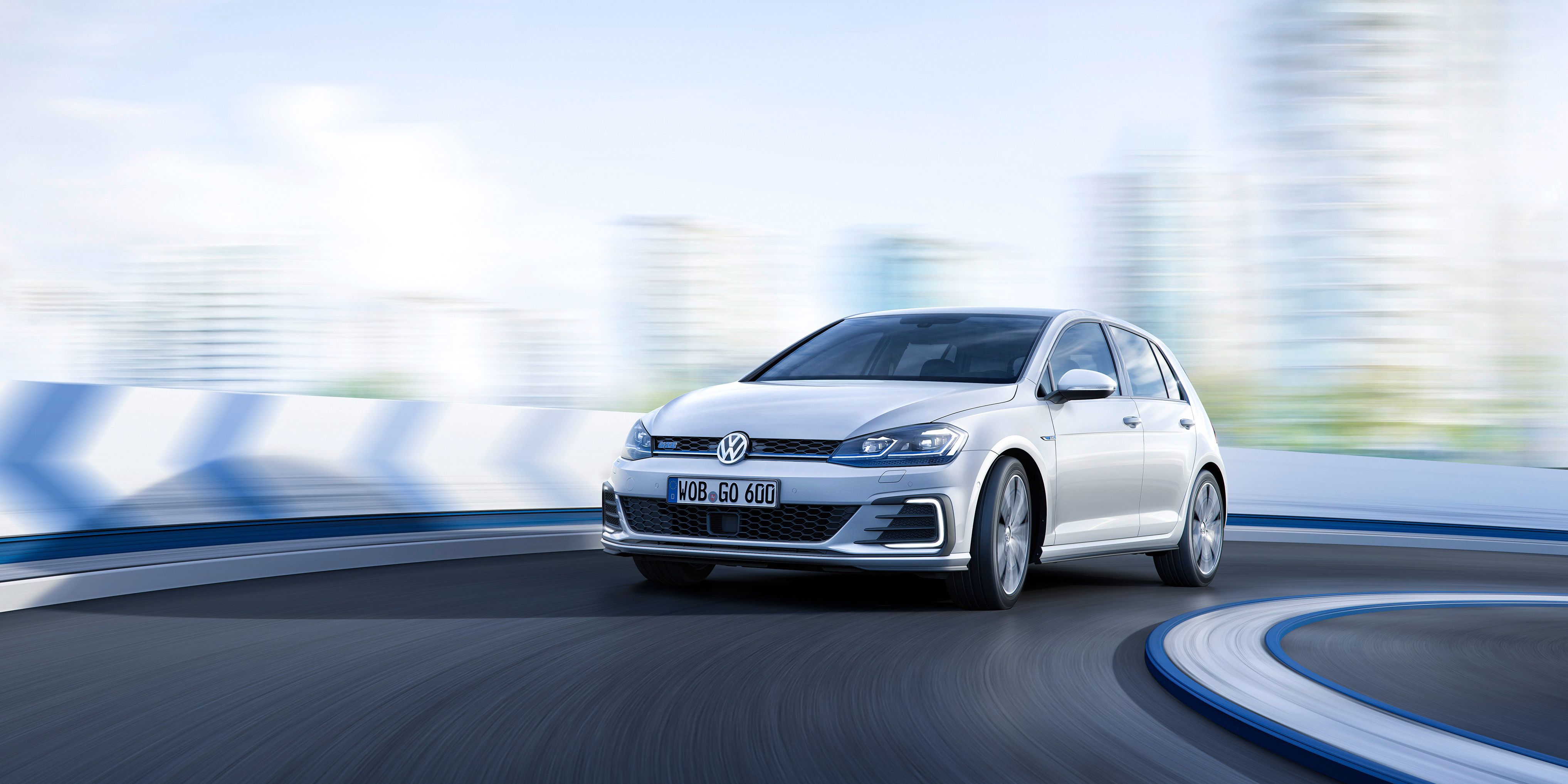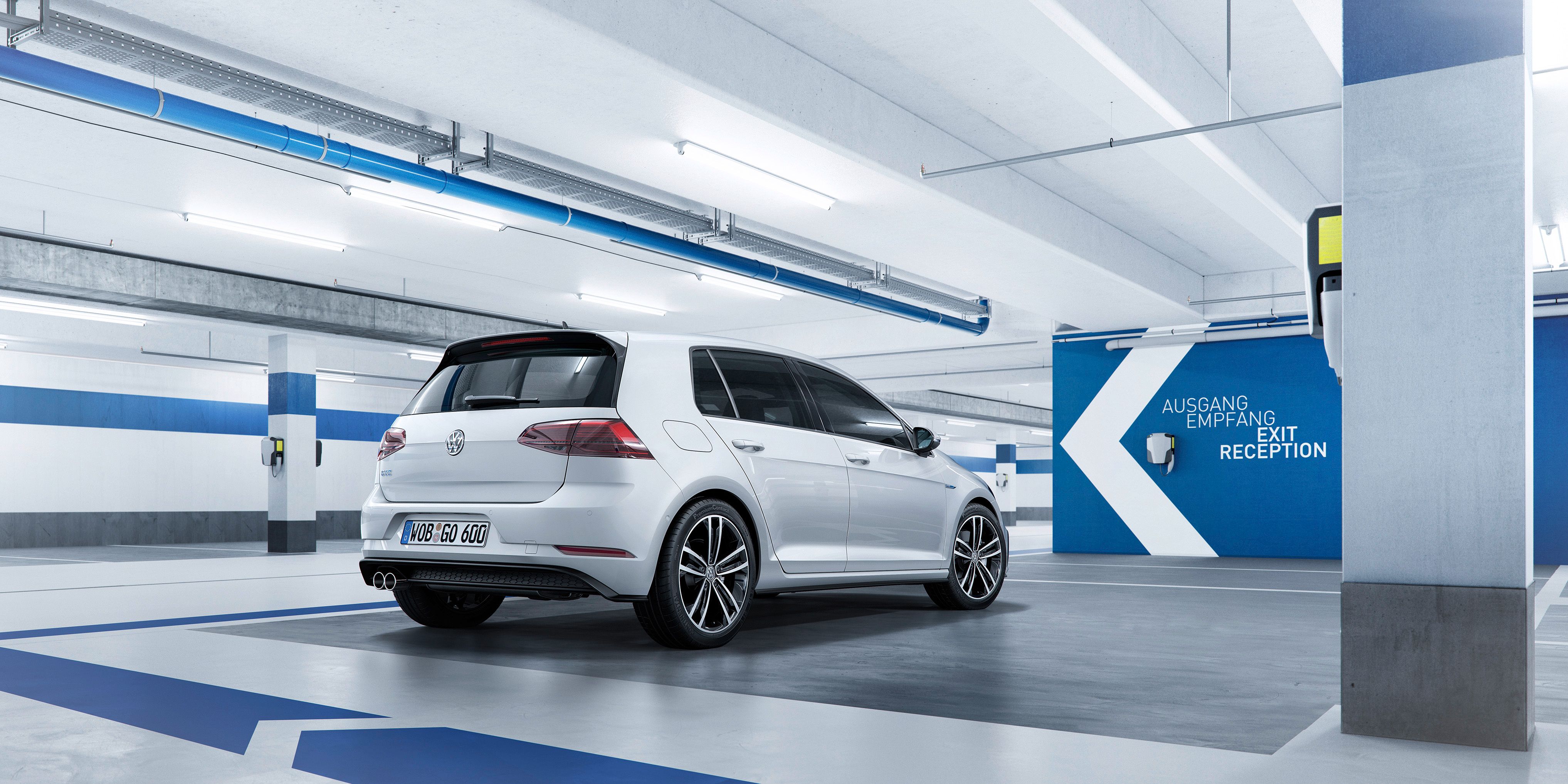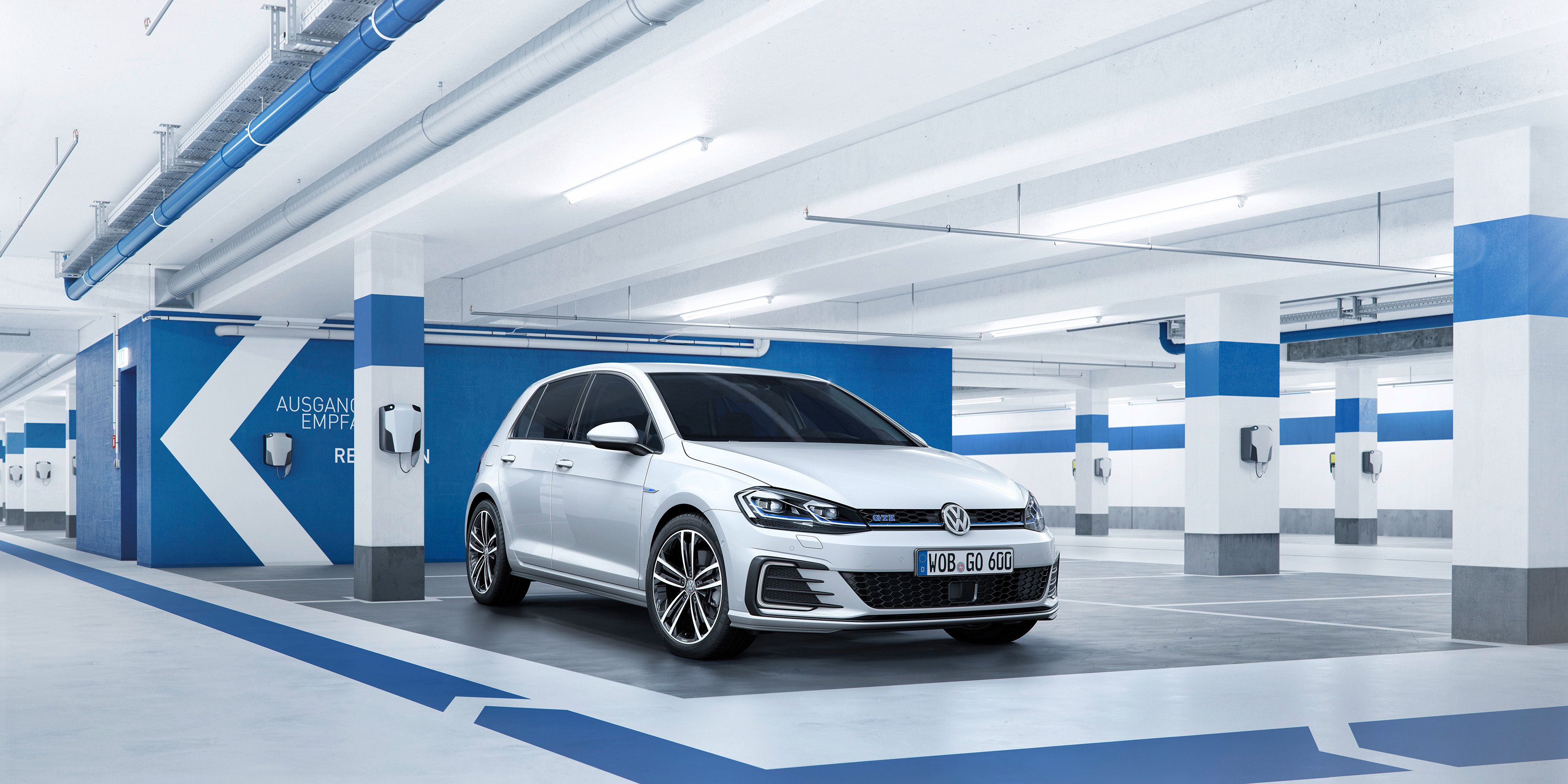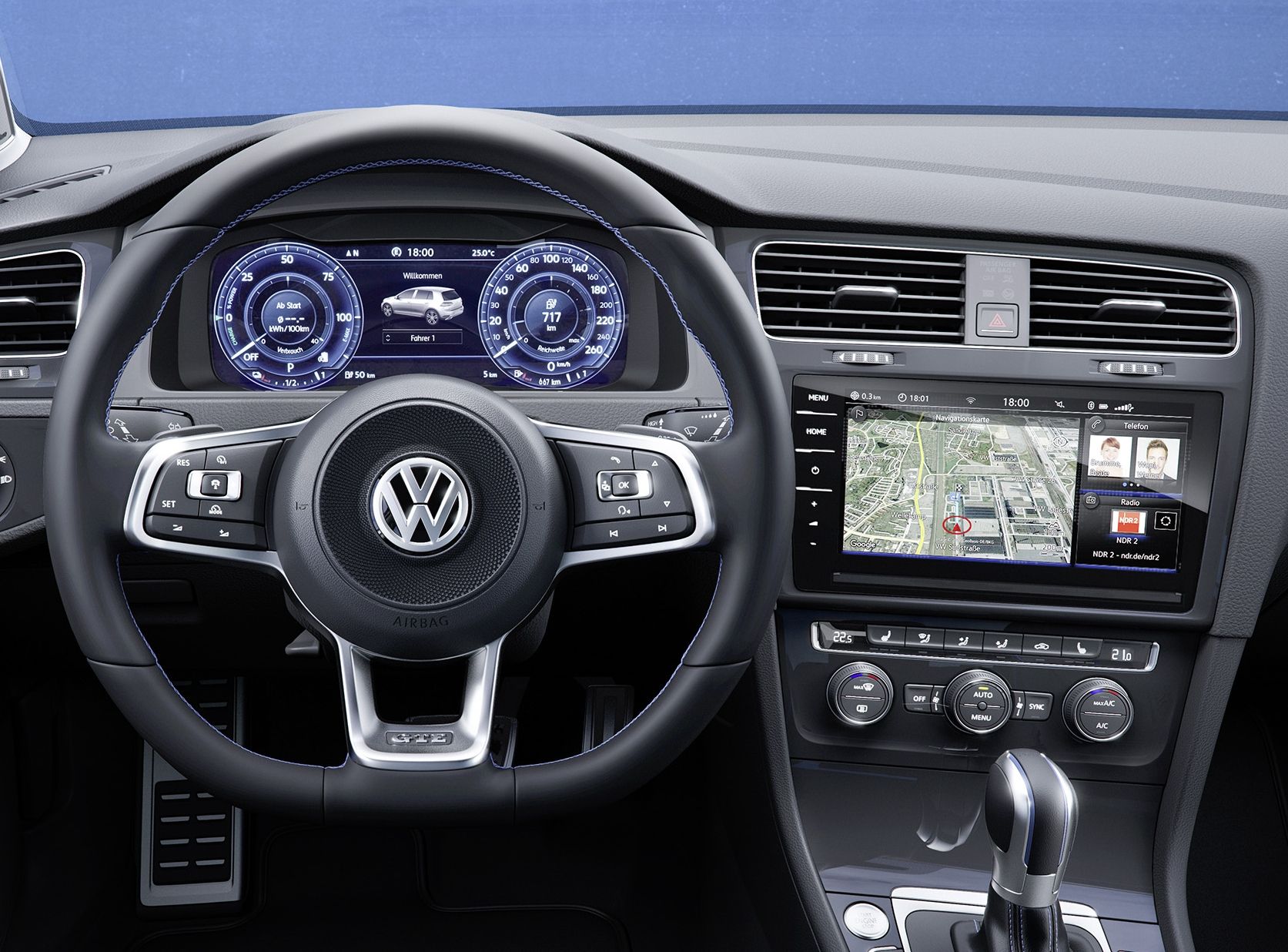Introduced for the 2015 model year, the Golf GTE is the very first plug-in hybrid version of the popular compact hatchback. It's also the model that debuted Volkswagen's new family of GTE vehicles, which now includes the Passat, Passat Variant, and Tiguan. Essentially identical to its gasoline and diesel sibling inside and out, save for a few hybrid-specific features, the Golf GTE uses a drivetrain that marries a small-displacement TSI engine and an electric motor. With a theoretical combined range of more than 900 km (at least 500 miles), the Golf GTE became a major success in Europe, becoming the second-best selling plug-in hybrid in its first full year on the market.
Come 2016, and Volkswagen launched a mid-cycle facelift for the seventh-generation Golf, which has been in production since 2012. Although the GTE is still relatively new, it was included in the upgrade and gained a handful of new features on the outside and loads of new technology on the inside. Unlike the regular Golf and GTi though, the hybrid carries over with the same drivetrain. However, this isn't unexpected, as the powertrain is potent enough as it is and its estimated mileage is as competitive as they get.
The upgraded Golf GTE is all about good news really, but Volkswagen has yet to say whether it will make it to the U.S. or not. Chances are it won't cross the pond in the current generation, meaning customers will have to settle for the all-electric e-Golf for the time being. Until that changes, let's have a closer look at what the revised Golf GTE brings to the table.
Continue reading to learn more about the Volkswagen Golf GTE.
2017 Volkswagen Golf GTE
- Make: Array
- Model: 2017 Volkswagen Golf GTE
- [do not use] Vehicle Model: Array
Exterior
It's common knowledge that Volkswagen facelifts are usually mild, and the update applied to the Golf Mk7 is no exception from this rule. The GTE model gets all the new features we've already seen on the regular hatchback, including the bottom radiator strip that extends through the LED daytime running lights and new LED headlamps. The front bumper was also redesigned, now sporting a wider grille, reshaped foglamps, and a black strip just below the license plate. A less noticeable but important change is the repositioning of the radar sensor for Adaptive Cruise Control and Front Assist system from the lower cooling air intake behind the emblem in the radiator grille.
Up front, there's just one feature that sets it apart from the standard Golf. While the latter comes with a chrome grille strip, the GTE has it finished in blue.
Around back, the hybrid hatchback sporty new LED taillights, but it's not yet clear whether the animated flowing indicators and the switch-over between the taillight and the brake lights functions available for the more expensive trim levels are offered on the GTE too. Other than that, everything remains unchanged compared to the outgoing model.
COMPETING DESIGNS
The Golf GTE doesn't have many rivals in its class, and its main competitor is actually based on the same underpinnings. I'm talking about the Audi A3 e-tron (left), which is also fresh for 2017 following a mid-cycle facelift. Although the A3 also sports a rather conventional design that's not supposed to draw attention, the sharper "Singleframe" grille contours and the more angular headlamps give the Audi a sportier stance compared to the Golf. The prominent character line above the side skirts also helps the A3 stand out in this niche.
Then there's the Toyota Prius (right). Sure, it's not a traditional hatchback and it's a some 11 inches longer than a Golf, but it's the oldest hybrid nameplate on the market and one of the main reasons why the Golf GTE isn't more popular around the world. The Prius used to be a dull and ugly car, but the 2015 redesigned pumped new life in the Japanese hybrid. But while the new styling is more pleasant to the eye, it's still somewhat unconventional and has very little in common with other Toyota products. If you're looking to stand out, the Prius is your best choice here.
Interior
Much like the exterior, the interior carries over with minor changes as far as styling goes. Visual modifications include only new trim panels for the doors, dashboard, and center console, new seat covers, and customizable ambient lighting. However, there are plenty of new features in the technology department.
Much like the conventional Golf, the hybrid model received new touchscreens based on the Active Info Display system. The main novelty here is the addition of gesture control, which makes the Golf the first production Volkswagen with this function. However, this feature is offered only with "Discover Pro", the range-topping and more expensive infotainment system.
The infotainment itself benefits from an update that includes a new-generation MIB display with larger screens. The size of the touchscreen depends on the configuration selected. "Composition Color" has a 6.5-inch screen, "Composition Media" and "Discover Media" come with 8.0-inch displays, while "Discover Pro" has a 9.2-inch touchcreen. While gesture control is optional, touch- and voice-command are standard.
The instrument cluster is also new, now fully digital and displayed on a 12.3-inch screen that includes navigation in 2D or 3D. The instrument cluster has five different information profiles, including “Classic”, “Consumption & Range”, “Efficiency”, “Performance & Driver Assistance” or “Navigation.” Each profile displays information and graphics differently in certain areas, but their names make them easy to identify and get used to.
The Golf GTE also comes with a new Media Control app, which is an infotainment interface for tablets and smartphones. The app can be used to control many of the functions of the infotainment system from a tablet or phone by connecting these devices to the “Discover Media” or “Discover Pro” infotainment system using the WiFi hotspot.
Volkswagen also added the Security & Service package, a bundle that gives the driver immediate access to assistance in a wide range of situations. Services include Automatic Accident Notification, Breakdown Call, and Service Scheduling. Breakdown Call allows the driver to use the infotainment system to contact the Volkswagen Emergency Call Center for assistance or medical attention, while the system already sends the vehicle data and its location to the emergency services when the driver calls for roadside assistance.
COMPETING TECHNOLOGY
Much like the Golf, the A3 didn't change much design-wise after the facelift, but it did get new features and tech. First, the hatchback gained Audi's virtual cockpit, which comes with a new, digital instrument cluster and a 12.3-inch screen. The MMI system has also been upgraded, featuring a new menu structure that is similar to that of smartphones. The seven-inch display is standard equipment, but optional upgrades add Google Earth and Google Street, and real-time traffic information. There's also 4G LTE connection and a MMI Connect app that allows online media streaming.
The Prius' interior is arguably the most interesting design-wise, largely thanks to its thin and wide, center-mounted instrument cluster and massive, wrap-around dashboard. However, you can't get as many fine materials as in the more expensive Golfs and A3s and gesture control might not be on Toyota's list for a few more years. On the other hand, the Prius' fetches around €10,000 less than a Golf GTE in base trim in Europe.
Drivetrain
Unlike the rest of the Golf lineup, the GTE remained unchanged under the hood. Motivation comes from the same 1.4-liter TSI engine rated at 150 PS (148 horsepower), while an electric motor steps in with an additional 102 PS (101 horses). Total ouput is rated at 204 PS (201 horsepower), while total torque is a remarkable 350 Nm (258 pound-feet). The torque output is similar to that of the gasoline-powered, performance-oriented GTi, which pretty much explains the GT in GTE.
All that oomph is routed to the wheels through a six-speed DSG transmission with a triple-clutch system specially developed by Volkswagen for its hybrid vehicles. The electric motor is integrated into the gearbox housing, while further hybrid components include power electronics and a charger.
Performance-wise, the GTE is a solid performer for a hybrid. The hatchback needs 7.6 seconds to hit 62 mph, while top speed is limited at 135 mph. Granted. these figures are nowhere near to that of the GTi, but bear in mind that the GTE is around 260 pounds heavier due to the battery and hybrid system.
When used in electric mode only, top speed drops to 81 mph, while mileage is estimated at 31 miles. On the other hand, its combined range is an incredible 933 km (580 miles). Sure, this number is theoretical and it can't be achieved in the real world, but the hatchback will travel for at least 400 miles on a single charge if the accelerator pedal doesn't get too much abuse.
The battery is an 8.8 kWh lithium-ion unit that takes just three to 3.5 hours to charge from a conventional plug, or 2.5 hours on a charging station. Volkswagen says that the Golf GTE doesn't emit more than 40 grams of carbon-dioxide per km.
COMPETING PERFORMANCE
While choosing between the Golf GTE and the A3 e-tron styling-wise will require some thinking, the two are identical under the shell. The A3 gets its juice from the same 1.4-liter gasoline and electric motor combo that produces the exact same amount of power. Even the battery is identical, but there are a few differences worth mentioning. First, the A3 comes with its very own transmission in the form of a six-speed S Tronic dual-clutch. The gearbox can be equipped with paddle shifter via the Sport package. Charging times vary, with Audi claiming an eight-hour charge on a 110-volt socket, while a 240-volt source will fill the battery up in two hours and 15 minutes. Unlike the Golf GTE, the A3 e-tron also comes with solar charging. All-electric range, total system mileage and 0-to-62 times are similar, so this battle is mostly about looks.
Moving over to the Toyota Prius, the car that already benefits from decades of know-how, its drive system includes a new 1.8-liter four-cylinder, a permanent magnet AC synchronous motor, and an 8.8 kWh battery. The gas engine is rated at 95 horsepower and 105 pound-feet, the electric motor generates 71 horses and 120 pound-feet, while total output is 121 horsepower. Significantly less powerful, the Prius is also slower, needing 11.1 seconds to hit 62 mph. That's 3.5 seconds slower than the Golf GTE. Top speed is also inferior at 115 mph. All-electric range isn't better at only 22 miles, but the total system range is comparable to the Golf GTE at 565 miles on the highway and more than 600 miles in city traffic.
|
Volkswagen Golf GTE |
Audi A3 E-tron |
Toyota Prius |
|
|
Drive system |
1.4-liter TSI + Electric |
1.4-liter gasoline + Electric |
1.8-liter four-cylinder, a permanent magnet AC synchronous motor, and an 8.8 kWh battery |
|
Total output |
201 HP |
201 HP |
121 HP |
|
Total torque |
258 LB-FT |
258 LB-FT |
|
|
0 to 60 mph |
7.6 seconds |
7.6 seconds |
11.1 seconds |
|
Top Speed |
135 mph |
135 mph |
115 mph |
|
Electric Range |
31 miles |
31 miles |
22 miles |
|
Total Range |
580 miles |
580 miles |
600 miles |
Safety
The GTE benefits from all the new safety system introduced with the Golf facelift. New technology includes Traffic Jam Assist, new Pedestrian Monitoring for Front Assist with City Emergency Braking. The new safety package also includes Emergency Assist and a refined passenger protection system. Carryover safety features include front airbags, driver’s knee airbag, side head and chest airbags, airbag cut-off switch, seat belt reminder, and ESC.
What Other Are Saying
CAR AND DRIVER
Car and Driver's Jen Meiners says that the Golf GTE is a solid performer in its segment, being superior to the older and more experience Toyota Prius: "The GTE is perhaps as rewarding a plug-in hybrid as we’ve experienced. Compared with, say, a Toyota Prius plug-in, the GTE simply plays in another league."
WHAT CAR?
On the other hand, the folks over at What Car? believe that while the GTE "makes sense if you do lots of short trips, the hybrid is not as "economical as the diesels, nor as quick or fun as the GTI." The outlet argue that the hatchback is well equipped and spacious, but pricey and at a disadvantage due to its small trunk.
Prices
Pricing for the updated Golf GTE has yet to be revealed, but it shouldn't be a lot more expensive than the outgoing model. With the 2016 model retailing from €36,900, the updated hybrid should fetch a little more than €38,000 before options.
HOW EXPENSIVE IS THE COMPETITION?
Being based on the same platform and using an identical drivetrain, it's natural to expect for the A3 e-tron to be only slightly more expensive than the Golf GTE, despite the extra premium goodies. Luckily, this is indeed the case, as the facelifted Audi retails from €37,900 in Germany. That's a €1,000 premium, which will be cancelled when the updated Golf GTE arrives in showrooms with a slightly more expensive sticker.
When talking about the Toyota Prius, pricing drops dramatically. Developed for cost-conscious drivers, fitted with far less upscale features, and using a less powerful drivetrain, the Prius starts from €25,150. However, it's worth mentioning that this is the regular hybrid and not the plug-in version. The latter starts from €36,600, which makes it only €300 more affordable than the Golf GTE.
|
Volkswagen Golf GTE |
€38,000 (est.) |
|
Audi A3 E-tron |
€37,900 |
|
Toyota Prius Hybrid |
€25,150 |
|
Toyota Prius Plug-in Hybrid |
€36,600 |
Note: German prices listed here
Competition
Audi A3 e-tron
The A3 e-tron is actually older than the Golf GTE, having been unveiled at the 2013 Geneva Motor Show and sold for the 2014 model year. As mentioned earlier, its drivetrain is identical to that of the Golf, while performance and mileage figures are either identical or very similar. Design-wise, the A3 e-tron is a regular A3 with "e-tron" badges and a charging socket hidden behind the four rings logo, while the interior stands out by means of hybrid-specific displays and menus. Unlike the Golf GTE, which isn't available Stateside, the A3 e-tron can be purchased in the United States.
Find out more about the Audi A3 e-tron here.
Toyota Prius
Redesigned for the 2016 model year, the Prius sports a completely new exterior that even though it is still linked to the previous model, it's more futuristic and youthful. Still unique in a rather weird way, but hey, it no longer looks like only people in their 40s and 50s would buy. Using a revised version of the previous 1.8-liter four-cylinder and a new electric motor, the new Previous boasts improvements in the performance department, but it's not the kind of car that would given the GTE a run for its money in a straight line. On the flipside, its total system mileage is as good, while the significantly more affordable sticker of the base, non-plug-in model makes it a great choice for drivers on a tight budget.
Learn more about the Toyota Prius here.
Conclusion
The facelifted Golf GTE might soldier on with the "old" drivetrain, but this isn't an issue. Although the hybrid system debuted more than three years ago in the Audi A3 e-tron, it's still peppy enough to maintain the Golf as the sportiest hybrid in its class, and it's powerful enough to trump the brand-new Toyota Prius. It's all-electric and total ranges are solid to say the least, while the well-equipped interior puts in on the more premium side of the market. The mildly revised exterior and the new technology will definitely keep the hybrid hatchback fresh for a couple more years.

